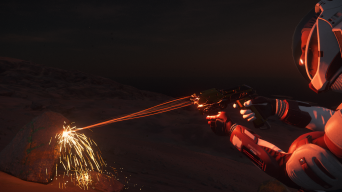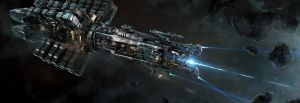
Mining is the extraction of minerals or other materials that are found on various planets, moons, and asteroids to be sold for profit. Mining is done primarily with ship-mounted mining equipment, or with hand-held mining tools; and can be done in open space, on a planet/moon, or underground. Minerals that can be obtained through mining include both productive and exotic materials, such as 艾格瑞金屬, 剛玉, 鑽石, 金, and 鈦.
Mining was introduced in Star Citizen Alpha 3.2.0 alongside the first mining vessel, the 勘探者
Techniques

Mining techniques can be separated into two common excavation types: surface and sub-surface mining.
Surface mining
Surface mining is the extraction of any minerals from the surface of a planet, moon, and asteroid. Surface mining is the most common type of mining done within the universe for which this is where most minerals lie. This technique relies on using a ship's mining head for the prospect, fracture, and extraction of a mineral deposit.
Sub-surface mining
Sub-surface mining is the extraction of any minerals from underground caves and caverns. Harvestable minerals are often the only minerals found while sub-surface mining. This technique is often called "FPS mining" or "Hand mining", and is a mining technique that does not require the use of any dedicated mining ship. FPS mining is currently only available by using the Pyro RYT Multi-tool with an OreBit Mining Attachment and often accompanied by a MacFlex Rucksack Core.
Mining Vessels
MISC Prospector

The 勘探者 has long been the preferred ship for solo miners and surveyors throughout the universe. Featuring MISC's sleek design sensibility, a bevy of high-tech mining tools, and dedicated storage pods for extracted resources, this utilitarian powerhouse perfectly balances form and functionality.[1]
ARGO Mole

The Argo Astronautics 鼴鼠 (Multi Operator Laser Extractor) is a medium-sized multi-crew mining ship. With three independent mining turrets and comprehensive crew facilities, it is a ship perfect for efficient multi-crew mining. In addition, a large array of 24 mineral pods ensures that nothing valuable will ever be left behind. The MOLE lives by the adage "many hands make for light work" [2]
RSI Orion

The 獵戶座 is the premiere multicrew mining ship in the universe, utilizing up to seven crew stations for efficient, rapid mining of large ore deposits. The Orion's features include high-grade turret-mounted tractor beam arrays, plenty of mineral storage and a cabin designed by the team that brought you the Aurora and Constellation.[3]
Mining Gear
Mining Lasers
Every vessel dedicated to mining has one or more mining lasers capable to fracture and extract large mineral deposits.
| Lancet MH1 | Greycat classifies the Lancet as a support laser best utilized when mining with others. Generating a weaker than average beam, the Lancet safely heats deposits to reduce their resistance and instability but struggles to shatter them on its own. For mining crews, it's an ideal support laser to use alongside other mining heads. |
| Arbor MH1 | The Arbor mining laser became the universe's most heralded mining laser head thanks to Greycat Industrials' exacting standards and business prowess. The laser heads solid reliable design found favor amongst industrial and solo operations for effectively balancing speed and safety. Greycat capitalized on this reputation by securing exclusive contracts that made the Arbor the standard laser head on most mining ships. |
| Hofstede-S1 | Built with safety in mind, the Hofstede-S1 sacrifices range and focuses on dampening a deposit's instability to make it safer to mine. Miners looking to decrease the chance of a catastrophic explosion should turn to this reliable and affordable mining laser from Shubin. |
| Klein-S1 | Shubin designed Klein to generate a powerful laser that increases mining speed. This increased speed incurs additional risk by boosting a deposits instability and chance of exploding, but if used correctly, the Klein can quickly reap rewards for the careful miner. |
| Impact I | Mine difficult deposits easier and faster with the Impact. Thermyte Concern created special focus lenses to increase the laser's power and provide the precision required for a larger optimal charge window. This powerful mining laser head does require careful management, as deposits will overheat quicker and explode with more force. |
| Helix I | Thermyte Concern engineered the Helix to be a mining laser impressive power and increased range to make it ideal when dealing with difficult deposits. Yet, all this power can be dangerous, as it also slows the throttle's responsiveness and increases the intensity of explosions. To some, the effective use of the Helix has become a sign of a true mining professional. |
Mining Laser Modules
Pilots can modify their mining laser's performance and behavior by augmenting it with up to three mining laser modules.
Personal Equipment
Pyro RYT Multi-tool
The Greycat Pyro RYT Multi-tool (or simply Personal Multi-tool) is a personal item that is equipped with the capabilities of a small-scale version of a workshop's Repair Arm.
OreBit Mining Attachment

The OreBit Mining Attachment enhances the Pyro RYT Multi-tool by allowing mining capabilities such as scanning and fracturing.
Backpacks
Backpacks provide ample storage space to house extracted harvestable minerals.
Mining Process
Before a mineral is sold to the market, it must first undergo a four-stage process which includes: Prospecting, Fracturing, Extraction, and Refinement.
Prospecting
The first step to any mining operation requires the discovery of minerals to occur. Using a ship's dedicated scanner, a mining crew would search by "pinging" the area for any mineral deposits. If sub-surface mining, this stage is done without the use of any equipment other than a miners' observation and knowledge of harvestable minerals. Once a mineral deposit has been discovered, a further in-depth scan is done to determine the composition of the deposit. Once minerals are confirmed and merited, the next stage begins.
Fracturing
Mineral deposits consist of very dense rock and are often large in mass. Before a rock is able to be extracted, it must first be broken down into smaller fragments. This stage is done by using a dedicated ship's mining laser or hand-tool to emit a powerful laser into the rock to increase its energy level high enough to cause the rock to fracture. This process is very delicate for emitting too high of a laser's energy into the rock will cause an explosion that can seriously harm or cause death to the mining crew. Once the rock is successfully broken into smaller fragments, the next stage can occur.
Extraction
This process is when a mining crew, after a rocks fracture, breaks down the fragments for transport. This is done by using a dedicated ship's extraction beam which will automatically breakdown the fragment and simultaneously moves the rubble to its storage bay. If the FPS mining technique was used, this process is done by simply moving the mineral into a miner's storage compartment. The extract raw minerals are then usually sold after this stage to various landing zones.
Refinement
The final stage in a mining operation is to remove the impurities and unwanted elements from the extracted rock in order to be sold. This stage is often done by major landing zones but can be done by the mining crew for greater returns using an integrated refinery as within the RSI 獵戶座.
Specialists Positions
In order to achieve a successful mining operation, large ships often assign their crew positions for increased efficiency and productivity. Such positions include the Pilot, Scan Operator, Beam Operator, Cargo Operator, and Refinery Operator.
Pilot
The pilot is responsible for the operation of the vessel as well as the safe transport of its passengers and cargo, determining safe routes, calculating fuel, and make the final call as to which individual asteroid warrants the most immediate attention, often choosing from an array of possible targets identified via the scanning process. They also determine whether to remain in a fixed position around an asteroid throughout the excavation process or to adopt a more active role, gradually rotating around a selected asteroid and thus giving the beam operator a better opportunity to find and extract valuable pockets of buried ore.[4]
Scan Operator
The scan operator is responsible for injecting remote material analysis packages (RMAPs) into nearby asteroids that, upon success, immediately begin sending telemetry data back to the pilot and scan operator informing them as to the asteroid's precise material composition. Depending upon the ship and its associated hardware, anywhere from several dozen to hundreds of RMAP-equipped manually guided missiles may reside upon a mining vessel.
Upon selection of an asteroid, the center of mass is automatically calculated and the scan operator begins the process of gradually scanning for a suitable RMAP insertion point. This is a multi-faceted process involving a search for a section of surface geometry oriented such that its perpendicular traverses the center of mass or somewhere close to it. The operator receives feedback on the angular difference, but it's ultimately their call as to whether a given site is good enough or not.
Once an insertion site has been selected, the location and optimal injection orientation are displayed, and the scan operator may launch an RMAP-equipped missile. The missile's thrust and guidance system are manually controlled, with the objective being to impact the asteroid at the precise point and with the exact orientation dictated via the previous step. The distance from the computer-specified injection position, deviation from the optimal angle, the base material of the asteroid, and final impact velocity ultimately determine whether an injection is successful or not.
One interesting aspect of this particular effort is that the confidence of the scan operator plays a significant role. The more optimal the initial insertion point selected – which typically takes more time to achieve – the larger the error can be in the subsequent missile guidance stage and still achieve a successful insertion. More skilled operators, therefore, will often be willing to accept even a mediocre insertion site so that they may quickly proceed to the next stage, confident in their ability to hit the precise location at the specified speed and angle such that they'll still be able to achieve success.[4]
Beam Operator

The beam operator is typically the second-in-command of a mining expedition. They are responsible for wielding the multi-megawatt mining beam generators affixed to one or more robotic arms near the front of the ship that fractures asteroids into fragments. The beam operator has direct control over the output wattage and is thus able to precisely control how much energy to dispense into a given area of an asteroid. This is critically important, as the injection of surplus energy into a volatile material can cause an explosive chain reaction to occur, with the total destructive force ultimately determined by the type and amount of reacting material. The beam equivalent of a sledgehammer, therefore, can be used to quickly excavate large quantities of inert materials, but a lower-wattage scalpel will be necessary when attempting to safely extricate those that may react violently in the presence of sufficient energy.
The Exothermic Reaction Detector is a status display on the beam operator's control panel that detects the production of excess energy indicative of the fact that the mining beam is causing a chain reaction in some portion of the materials in close proximity to the beam. This information is presented to the operator in the form of a vertical bar graph plotted over time showing the probability per second of such a reaction growing out of control and consuming – often in a powerful burst of energy that can send huge, dangerous shards of the asteroid flying towards the vessel – all of the material in the nearby area.[4]
Cargo Operator
The cargo operator utilizes a console on the bridge of the ship that allows them to monitor a camera mounted within the forward-facing input port. From that vantage point, the cargo operator can view the impact area of the mining beam, as well as the various asteroid fragments that are broken apart from the parent body and ejected out into space. The input port contains a powerful crusher that quickly reduces any incoming asteroid fragments to rubble and stores them in attached cargo modules for transport or, on ships with an integrated refinery, subsequent processing into their purified elemental forms.
The cargo operator directs a targeting cursor towards fragments of interest, with an integrated Fragment Scanner – similar to the Analytical Materials Processor utilized by the beam operator – providing immediate feedback in regard to the fragment's precise composition. In this manner, the operator is able to get a quick sense as to the relative value of the fragment, and whether it is worth attempting to guide it into the input port. The Fragment Scanner also displays the object's mass, trajectory, and velocity.
The cargo operator controls attractor and repulsor beam generators typically mounted just within or outside the input port, and the magnitude of the force generated by each can be precisely controlled so as to allow for intricate modification and control of a fragment's trajectory. The cargo operator's display allows for a variable magnification zoom, which is necessary since attractive and repulsive forces are applied at the precise location denoted by the target cursor. Application of force to a fragment's extremity, then, will typically result in generating a rotation on the object rather than any significant change in its direction. Thus, considerable skill – including the ability to quickly estimate an object's approximate center of mass – is required in order to efficiently apply forces and guide fragments along the desired path.[4]
Refinery Operator
The position of refinery operator only exists on mining ships that contain an integrated refinery. Refineries allow raw ore to be gradually converted into their purified component forms, with the undesirable elements being ejected back out into space in the form of dust. Purified materials consume a small fraction of the storage space of their unrefined counterparts, which is of particular concern when dealing with low-quality asteroid fields that possess valuable elements only in a highly diffused form, or when attempting to minimize the number of return trips back to a trading or storage facility. The refinery operator controls the routing of ore to a variety of specialized processing units, each of which has a different role to play in the separation of one material from another. Operator errors in the refinement process can cause sensitive equipment to fail, stalling the conversion process and costing valuable time until the affected item is replaced, typically with a surplus part stored in the ship's inventory.
All of the aforementioned specialist positions may be helmed by either a player or an NPC, with more experienced NPCs performing their duties in superior fashion, but usually at the expense of demanding a higher monthly salary.[4]
Trade and Development Division (TDD)
The Trade and Development Division - otherwise known as "TDD" - is a marketplace located in ArcCorp's Area 18, where information determining the supply and sense of demand of various commodities is shown for a given location.

| Approximate value per 100 units as of Alpha 3.8.1 | |||||||
|---|---|---|---|---|---|---|---|
| Bexalite | 40.50 | Hephaestanite | 14.70 | Beryl | 4.32 | Quartz | 1.51 |
| Taranite | 32.52 | Titanium | 8.68 | Tungsten | 3.99 | Aluminium | 1.27 |
| Borase | 32.44 | Diamond | 7.16 | Corundum | 2.65 | Inert Material | 0.02 |
| Laranite | 30.25 | Gold | 6.25 | ||||
| Agricium | 26.88 | Copper | 5.77 | ||||
References
- ↑ "The Prospector." RobertSpaceIndustries, Cloud Imperium Rights
- ↑ "The Argo Mole." RobertSpaceIndustries, Cloud Imperium Rights
- ↑ "The Orion." RobertSpaceIndustries, Cloud Imperium Rights
- ↑ 4.0 4.1 4.2 4.3 4.4 "Design Notes: Mining." RobertSpaceIndustries, Cloud Imperium Rights, 2015-02-20